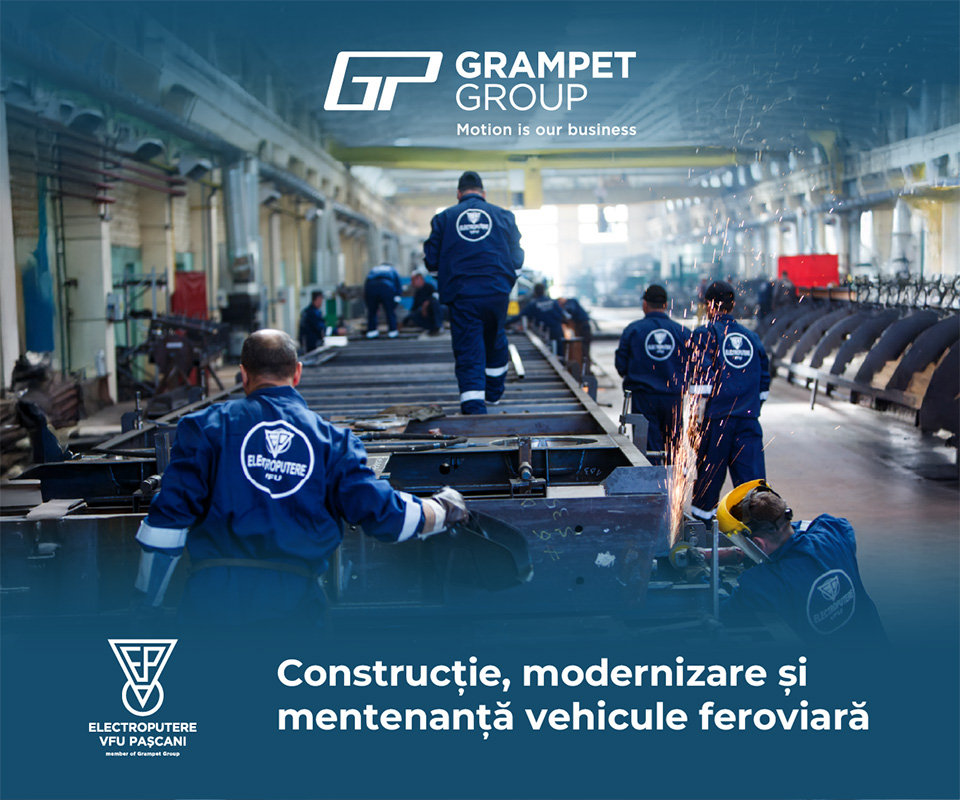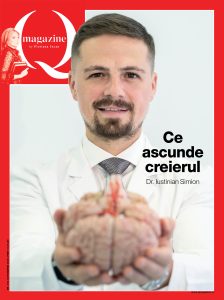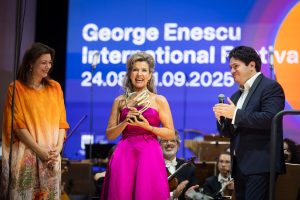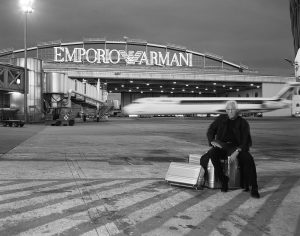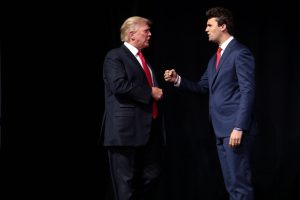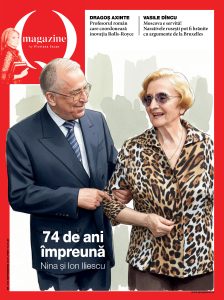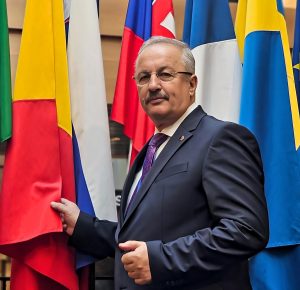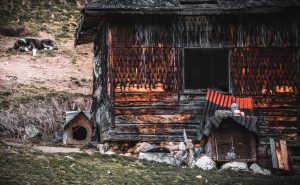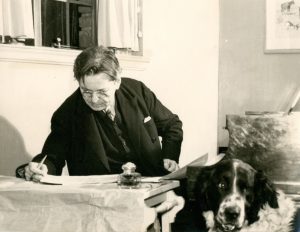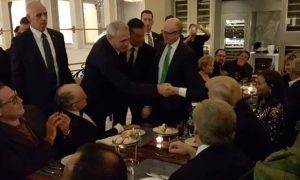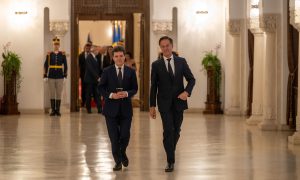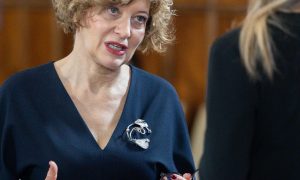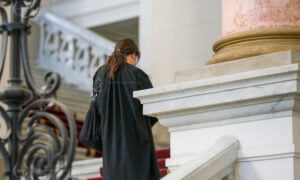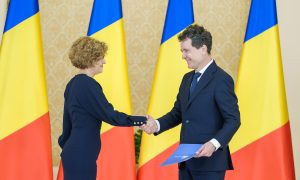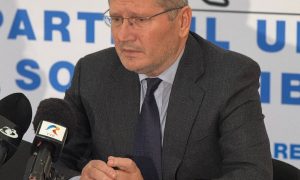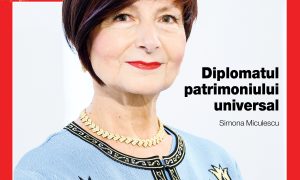War has an “unwomanly face”, according to writer Svetlana Alexievich. Nonetheless, women can achieve exceptional results in the military. The following pages bear witness to the fact that women in the Romanian Army can fly supersonic or strategic transport aircraft, command frigates or infantry units, rescue wounded soldiers in the theater of operations and beyond, and perform honor guard duties at the highest level. Some of these remarkable women have achieved these feats for the first time within the North Atlantic Alliance, which encompasses the armies of 32 countries.
Their accomplishments have been recognized with the support of Chiefs of General Staff, such as Nicolae Ciuca, aiming to highlight the exemplary human resources within the national defense forces.
The documentary created by Gabriela Simon, alongside photojournalists Cristina Anculete, Alexandru Rosieanu, and Costin Dinca, serves as Q Magazine’s tribute to the Romanian Army and the 20th anniversary of our accession to NATO this year.
FLORIANA JUCAN
- Cazul Lukoil. Bulgarii obțin prelungire de la americani, ungurii exceptare, noi… nimic. Se așteaptă noi creșteri de preț la benzină și motorină
- Ambasadorul Rusiei a fost convocat la MAE și i s-au prezentat dovezi concrete ale dronei trimise în Ucraina, căzute în România. Ce spun rușii
- Stiliștii au nevoie de stilist
- Din cauza lipsei de gardieni, deținuții au ajuns să se păzească singuri
- Grădina Operei Comice pentru Copii, transformată în orașul poveștilor de iarnă

THE SKY: A LIMIT OR A BEGINNING?
If Pete Mitchell’s role had been played by a Hollywood actress instead of Tom Cruise, would the movie “Top Gun” have been as successful? Regardless, Q Magazine presents the story of two female military pilots who could inspire at least one Romanian film director. SIMONA MAIEREAN and DIANA APOSTOL spoke to us from the cockpit of a Spartan, with which they have flown numerous missions.
Text: Gabriela Simon Photos: Alexandru Rosieanu
THE CONTROL STICK DOESN’T KNOW WHO’S OPERATING IT
Lieutenant Commander Simona Maierean, one of the women who has written an important page in the history of Romanian and NATO aviation, does not believe in coincidence. She adheres to the idea that “people are capable of anything until they start doing something.”

It’s been 21 years since Simona aimed to view the world from the sky. Her smile and determined gaze reflect a woman of strength and ambition, keen to prove that experience and professionalism are pivotal in aviation, just as in any other field. After all, the control stick doesn’t differentiate between genders.
“I had a desire to fly, though I wouldn’t say I was resolute. You know how life takes over, especially during adolescence. Eventually, I had to think about my future. I’ve always been a bit poetic, often daydreaming about flying. In other words, I was often flying above the clouds in my mind.
I imagined it would be wonderful to turn those dreams into reality one day. So, I applied to the Military Academy. I didn’t know if I was going to make it or not, but I was very relaxed nonetheless, because I had secured places in other faculties. Had I not succeeded, perhaps I’d have pursued fields like computer science, automation, or mathematics. Who knows? But I passed the exam, and that’s how my journey into aviation began. Two decades later, I am still here!” Simona recalled her beginnings.
When asked about the challenges of entering a male-dominated field, Simona’s response was unexpected.
“I didn’t think about it! When my father learned of my ambitions, he warned me I’d be the only woman among many men. But I didn’t focus on that reality. If I had, I probably wouldn’t have accomplished much. Sure, it was tough. Sure, I did things I didn’t enjoy. But my career was at stake. To achieve my dream, I needed the strength to overcome all obstacles. This wasn’t a decision made under pressure; it was the path I chose. Even after the Academy, it was difficult. So what? I kept moving forward”, Simona confessed.
My mind was often high above the clouds.

“WE MUST FLY TEN MINUTES AHEAD OF THE PLANE”
Seated beside this beautiful red-haired woman in the cockpit, I marveled at her poise and mastery. She occupied the pilot’s seat while I sat in the co-pilot’s position, surrounded by an array of buttons, switches, and levers. Curious, I asked if she knew the function of each one. She chuckled softly and replied, “Most of them, yes. But if I ever have doubts, I refer to the technical manual right there. You can’t thrive here without knowledge, without continuous learning, keeping pace with evolving technology. In fact, I think it’s true for any profession.”
Simona boasts two notable records: one nationally and the other across Europe. She was the first woman within NATO to pilot a supersonic aircraft and the first at NATO level to attain the highest certification as a pilot in command in the Strategic Airlift Capability (Heavy Airlift Wing). The road to the top was not “a walk in the park”, but nothing deterred her from achieving her goals.
“I don’t categorize situations as easy or hard; I measure whether they’re worthwhile. As a pilot—be it civilian or military—you often find yourself doing things you don’t particularly enjoy. For instance, I don’t know any pilot who relishes paperwork or filling out forms. Flying isn’t just about taking off and landing; it involves extensive preparation before and after missions. But even if you don’t like certain aspects of the job, you do them because you believe it’s worth it.
You know how it is – sometimes you feel queasy during maneuvers, but that doesn’t mean you give up, because you know where you want to go,” Simona Maierean shared with Q Magazine.

She was the first woman within NATO to pilot a supersonic aircraft and the first at NATO level to attain the highest certification as a pilot in command in the Strategic Airlift Capability (Heavy Airlift Wing).
When I asked Simona about her experience flying a supersonic plane, her eyes lit up, and her smile widened as she recalled the moment vividly.
“I still remember the roar of the plane, the G-forces, the vibrations of the engines synchronized with my own heartbeat during takeoff, the sheer speed of everything, and the split-second reactions required. There are countless details that make a significant difference.
Flying supersonic isn’t an everyday occurrence. Perhaps that’s why every sensation remains etched in my memory. Physically, you need to be exceptionally prepared because the body undergoes extra strain, and there are physiological effects to manage. It’s crucial not to appear incapacitated while controlling a supersonic aircraft; your muscles must be ready to act if needed. But you don’t need to be a superwoman or superman because, ultimately, it’s still a flight. Of course, you must be adept at handling various scenarios.
They say pilots need to fly ten minutes ahead of the plane. This means that you must anticipate what’s coming before it arrives, to ensure nothing catches you off guard”, Simona Maierean explained. She admitted surprise at the attention her supersonic flight garnered.
“I never imagined I’d be the first woman to pilot such an aircraft. Like my colleagues, I navigate through the usual stages of a career, and such milestones are exceptional particularly to those outside the field. Yes, I was the first woman, but not the only one. Another woman has also flown supersonic. Regrettably, only one other!” said Simona Maierean.

FROM SUPERSONIC TO SPARTAN
Three years after this landmark event in Romanian aviation, which took place in March 2009, Simona decided to pivot sharply in her career. Following her final flight with the MIG21 LanceR, she announced her intention to transfer and switch to a different aircraft. She hadn’t disclosed to anyone that it would be her last flight. She wanted everything to proceed normally, allowing her to savor the flight completely, yet it turned out to be an emotionally charged experience.
Perhaps driven by the impatience typical of youth, she was somewhat impulsive in her decision-making. The transition from the MIG to another type of aircraft had been debated for too long in Simona’s view. She believed that, given the pace of developments, she might be too old to fly the new aircraft type by the time it was acquired. Thus, she made the bold move from fighter jets—where she had also made history as Romania’s first female fighter pilot—to transport aircraft.
This new chapter, however, brought her numerous satisfactions.
“I had to relocate to a different airbase. While the people were different, the mechanics of flying remained the same; you just need to understand the specifics of each aircraft. Like in any other field, keeping up with technological advancements is crucial. I transitioned to becoming a C-27J Spartan pilot at the 90th Airlift Base Otopeni. In 2017, I joined the Strategic Airlift Capability (Heavy Airlift Wing) program.
It was an extraordinary period. I spent nearly six years at the international base in Budapest.
When the Afghanistan withdrawal unfolded, it was chaotic, as you know, but we managed the situations that arose very effectively. It was interesting.
Our mission was to fly into Afghanistan, transporting passengers, materials—everything necessary. I was stationed in Otopeni because it was a bit closer for our flights. We would take off, reach our destination, land, shut down the main engines but keep the auxiliary ones running to maintain electricity and air on board. The next crew, who was to replace us, would take the plane and leave. We would rest, and when they returned, we would take over the aircraft. A C-17 can’t stay operational for more than 72 hours, yet it had to be ready for takeoff during that time.
We didn’t actually stay in Afghanistan; we would go there and come back. It was safer to minimize our time there due to the exposure. After all, I was flying a massive plane.
Aviation is inherently risky. Embracing those risks demands courage—a lot of it,” Simona Maierean shared with Q Magazine.
I was curious to know which aircraft held a special place in her heart. Her answer was swift: “The C-17. That’s where I truly felt like a pilot, starting from scratch, so to speak. I began as a co-pilot, progressed to commander on the C-17, and eventually became an instructor, navigating through all levels. It was challenging because we had limited flying hours initially. We had to catch up. However, since 2014, there has been progress in our military aviation. It’s possible that in a few decades, pilots will be replaced by artificial intelligence. For every two pilots, there may be only one remaining, and even that could be viewed as problematic due to fatigue, slower decision-making, and emotional factors. Do you see how rapidly everything is advancing?” Simona Maierean remarked.
In 2022, she returned to Romania, joining the General Staff of the Air Force. Her voice conveyed a certain wistfulness that her life as a pilot was no longer as exhilarating and thrilling.

Aviation is inherently risky. Embracing those risks demands courage—a lot of it
“I’ve been at the Air Force General Staff for about a year and a half. Exciting!” she tells me ironically. “Nowadays, I find myself flying in the office! Last year, my flying hours were fewer, but this year I hope to ramp up my training intensity—not just confined to flights between four walls, but also getting back into the cockpit. Though I won’t be able to do what I did before— flights of 5 to 6 hours, even 10 to 11 hours—because at 40, as unbelievable as it may seem, one is no longer considered young for piloting,” Maierean explains. She emphasizes, however, that she “won’t hang up her wings”.
Wherever you are, clear skies, Simona!
MASTER OF THE HORIZON
Captain DIANA APOSTOL also lives a life infused with the scent of kerosene and proudly identifies herself as a “tourist” on the world map. On her blog (paperwings.ro), she introduces herself with these words: “I am a mother, a wife, a daughter, a sister, a friend… I am a mistress of the skies… I am an aviator…”. Diana’s life unfolds both in the sky, because “aviation gives a feeling,” and on the ground, with her two children, Ares and Lucas.

THE CHILD FROM THE JIU VALLEY
As a child, Diana didn’t dream of flying. Her aspirations leaned towards ordinary professions like a lawyer or a policeman. She is from a modest family in the Jiu Valley.
“My father was a miner, and my mother was a housewife when we were young, later returning to work. I have a sister, Isabela, who serves in the Land Forces.
I was one of those kids who loved school and learning. I recognized my potential early on and aimed high from the start.
The desire to wear a military uniform emerged in the 8th grade when recruiters presented Military High School educational opportunities, which I had not previously considered. I was uncertain about which high school to choose. The recruiters had a motto: Aim high, be the best! I told myself I had to pursue that path. I went home and shared my aspirations with my parents, who never clipped our wings and always encouraged us. They agreed to enroll me in the Military High School in Alba Iulia, where my military journey began.
It wasn’t until the 11th grade that I began to entertain thoughts of becoming a pilot. However, there were limited opportunities for women, so I hesitated to get my hopes up. Then, a pilot from Campia Turzii came to speak to us about the life of a military pilot. His calm and captivating presentation immediately fascinated me. He wasn’t there to convince us, but to provide insight. That’s when I decided that if there were any openings for women, I would certainly try my luck. I use the word ‘luck’ because before admission, you had to pass a rigorous medical examination. Preparation was futile; you either had the physical and mental fortitude for supersonic flight or you didn’t. Here’s how the medical examination was: they tested you for flying supersonic aircraft.
“I was lucky. In my 12th grade, there were 10 spots for women. However, during the physical tests, they screened us so rigorously that only nine women remained for those 10 spots. That’s when my passion for aviation began,” Diana Apostol shared with Q Magazine.
Since graduating from the Military Academy in 2012, Diana has been piloting a C27 J Spartan. “I flew an airplane before I drove a car. When I first flew solo as a commander, I didn’t even have a driver’s license yet. I went skydiving before driving a car.
“I have many fond memories, but the journey was tough. It was not easy then, and it’s still not easy now. Just because I’ve reached the point of flying this airplane doesn’t mean the preparation stops; it’s continuous hard work. And there are the sacrifices of military life, because above all, we are soldiers,” Diana Apostol explained.

I flew an airplane before I drove a car.
“SPARTAN WAS MINE!”
She willingly abandoned her dream of becoming a supersonic pilot.
“Out of the 30 students who enrolled in the academy, 28 obtained their military pilot’s license. Only half remained for supersonic aircraft; the rest were already qualified on helicopters.
Their decision was somewhat easier since they knew their next aircraft and only had to select a military base.
For us, the supersonic pilots, the path ahead was challenging, as it had been for all generations of military pilots in recent years.
We were slated for supersonic jets, but which one? The F-16 remained a distant aspiration, uncertain of when it would arrive in Romania. There weren’t enough slots or resources for so many young pilots on the MIG-21. Consequently, the entire class was redirected to Bacau to continue training on the IAR-99 SOIM. How long this phase would last was anyone’s guess; it was merely another transition.
If we aimed to remain in the supersonic track, this was our sole option for the time being. Meanwhile, some of us had found life partners, many were weary of the uncertainty, and others preferred to be stationed close to home.
That’s when I decided to relinquish my aspiration of becoming a supersonic pilot. I sought to strike a balance between my professional and personal life, an area I had frankly neglected until then. Transitioning to the C-27J Spartan, the newest aircraft in the Air Force fleet at that time, turned out to be the optimal choice for me. Once again, luck was on my side. In 2013, only one slot opened up for the C-27J Spartan, and it was mine.”
Diana acknowledges the ongoing challenge of balancing her life between the sky and the ground, confessing that she is still striving to find that equilibrium. Yet, she cherishes every aspect that brings fulfillment to her life: her career and her children.
“It’s hard to be fully present as a mother while being completely dedicated to my work at the same time. Sometimes, when the children fall ill, I stay home with them. They have become my top priority.
When I’m at work, I give it my all—it has to be that way. But now, I have two children waiting for me at home. There are moments when they need me there more than I’m needed here.
I chose to spend two years at home with each child because those are the only years we truly have together.
My job doesn’t follow a fixed schedule, where I leave at 8 a.m., return at 4 p.m., and then spend the rest of the day with them. Our days are so unpredictable. It’s not all smooth sailing, it’s not easy, but in both roles, it’s beautiful, and I wouldn’t trade what I have now.
My career progression took a bit longer because of the breaks I took during and after pregnancy. Each time felt like starting anew. These were the toughest moments in my career. As pilots, we must understand every aspect of the aircraft, not just the cockpit—knowing each button, how to fly, but also basic engineering, weather, navigation, and all civil regulations.
Flying involves rigorous training. It begins with takeoffs, landings, basic maneuvers, turns, and escalates in complexity.
A pilot must be versed in parachuting, cargo drops, landing on short runways in war zones, evading enemies. Medical flights demand a unique skill set.
If my entire crew were to perish and I found myself alone in the cockpit, I must be prepared to handle the situation. These flights are the ultimate tests. Engines may fail, pressure can drop suddenly, and you must be ready to don the oxygen mask. We are constantly being tested because, God forbid, should the worst occur, we must be prepared. We continually accumulate knowledge and skills,” Diana Apostol tells Q Magazine.

If my entire crew were to perish and I found myself alone in the cockpit, I must be prepared to handle the situation.
Flights that Diana Apostol considers very hard are those she made during the Covid-19 pandemic.
“I was involved in transporting the sick out of the country. Those missions were incredibly challenging because we had patients onboard and had to suit up like doctors, with two layers of clothing, gloves, and a visor. No water, no bathroom breaks—we couldn’t remove our gear to avoid contamination. These missions could last up to eight hours, and imagine dealing with a fogged-up visor that you couldn’t clear.

The Spartan aircraft is incredibly versatile. Depending on the mission, the entire interior configuration can change. For medical flights, the cabin is filled with stretchers and medical personnel dedicated to each patient.
During parachute jumps, we may remove all the seats. When dropping containers, everything is packed with water containers for firefighting.
It’s a highly complex aircraft with diverse capabilities, demanding thorough preparation for each scenario. The Spartan is designed for tactical operations, offering high maneuverability to evade threats. Every flight is unique for us pilots, requiring different operating systems and flight techniques.
For instance, in tactical situations, we must fly close to the ground at low altitudes.
When transporting patients, we must fly at a certain level to maintain a specific cabin pressure and at slow speed for their comfort. During parachute operations, precise parameters must be met to ensure safe jumps, with instructions relayed from the cabin”. Diana Apostol explained.
The conclusion she wanted us to take away in the end is that “for her, the sky is not the limit, but just the beginning!”
FIRST THE COUNTRY, THEN THE CHILD…
The visit to the 24th Infantry Battalion “Ecaterina Teodoroiu” in Targu Jiu stirred up mixed feelings. From the moment I arrived at the barracks gate, passing through the checkpoint, a sense of decay and dilapidation pervaded my thoughts. Stepping into the courtyard only solidified this impression. However, my perspective shifted drastically upon meeting Lieutenant Colonel Raluca Popescu, the unit’s commander. By the time I departed, I was filled with profound admiration for the remarkable woman leading the battalion.
Text: Gabriela Simon Photos: CRISTINA ANCULETE

INSPIRED BY “G.I. JANE”
I already knew that Lieutenant Colonel Raluca Popescu had participated in missions in Afghanistan and Côte d’Ivoire, but when I entered the military unit’s gate, disappointed by the dilapidated appearance of the buildings, the first thought that crossed my mind was, “What is an officer of such caliber doing in Targu Jiu?” Sensing my visual shock, she said, “I know what you’re thinking, but the next time you come, you’ll see something completely different. We’re just getting started, but progress is underway.” Her voice resonated with optimism rather than excuses. Inside an unassuming office, she shared her story and the story of the place.
“The 24th Infantry Battalion, named after the female hero Ecaterina Teodoroiu, was founded just last August. For about 20 years, the barracks were guarded, but not utilized or maintained. It’s a challenging project because you’re practically starting from scratch on all fronts: from building our ranks and enhancing technology to developing infrastructure. It’s a gradual process that demands time and resources, but the results will speak for themselves. Sudden changes overnight are just not possible,” Raluca Popescu explained to Q Magazine. Starting with a mere seven soldiers in its inaugural week, the battalion has since grown to 72.
Her roots are in Targu Jiu. She has over 18 years of military experience in operational and command roles – from platoon and company commander to general staff officer, then chief of combat engineering and EOD (Explosive Ordnance Disposal) office, and engineering battalion chief of staff. A true warrior.
“I really wanted a military career. I had no prior connections to the Army aside from an uncle who served as a sergeant. But I had seen the movie ‘G.I. Jane’ with Demi Moore, which depicted the first woman undergoing special operations training similar to that of the US Navy SEALs. Due to my tomboyish and independent nature from a young age, I opted not to pursue my original plan of attending Polytechnic, but instead enrolled in the Land Forces Academy in Sibiu. Upon graduation, I made a personal vow to return to Targu Jiu. My intention was to join this very unit, that operated the air defense systems at the time. I aimed to become an artillery officer and serve close to home. However, between 2003 and 2005, the unit was unexpectedly closed, which temporarily shattered my dream,” she recounts.
Although she had been a civilian, she quickly adapted to the strict military rules. Over time, she even found herself attuned to the system. “There was only one moment when I seriously considered quitting. Upon entering the Military Academy, we were confined for seven weeks and not permitted to leave until we took the oath of allegiance. That was the protocol. However, I had a significant reason that I believed my superiors would understand: my cousin was getting married. I had everything planned, from buying my dress to envisioning myself as a bridesmaid. Unfortunately, my request for leave was denied. It was a heartbreaking moment when I contemplated leaving. I had hoped to attend my cousin’s wedding and perhaps catch the bouquet. It was a tough setback, but I eventually rebounded. For someone transitioning from civilian life, the adjustment to barracks confinement, after being accustomed to freedom of movement, was quite a shock. Yet, despite these challenges, the dropout rate at the Military Academy is low. Moreover, conditions have improved in recent years.”

FROM ENGINEERING OFFICER TO UN OBSERVER
Although Raluca Popescu had the option to choose infantry, she opted for military engineering, a specialized branch focused on fortifications, roads, and bridges. Growing up in a family of engineers, she felt it aligned perfectly with her style and personality.
Ironically, she now commands an infantry battalion after completing a joint command master’s program that qualifies her for various military functions.
She served two tours in Afghanistan as an engineering specialist and one in Côte d’Ivoire as a UN observer.
“I appreciated the structured activities and standardized procedures. You know exactly what to do. For newcomers, it’s about studying these procedures and learning the ropes. The theater of operations itself is an experience unlike anything in a domestic military unit. It’s a completely different environment—from climate to culture, risks, and everything else. You know what I felt? That my work really mattered, that it could mean the difference between life and death.
In the first mission, in Afghanistan, our main job was to ensure freedom of movement on the highway. Locals would plant IEDs under bridges and then detonate them. Incidents happened frequently on Highway 1. Did you know that both Romanian and American soldiers faced losses in Afghanistan? Thirty Romanian soldiers lost their lives there. Our mission, alongside the Americans, involved constructing metal bridges to restore freedom of movement. These bridges weren’t just for military use but also benefited civilians. In that context, I felt the significance of our work. While similar projects can be carried out at home, the impact isn’t as palpable.”
Soldiers who went to Afghanistan suffered severe shocks. There were cases where comrades were dismembered next to them, where they woke up with a comrade’s leg in their hand. Terrifying. Fortunately, Raluca Popescu did not encounter such extreme events. Apart from a few alarming situations, she did not experience traumatic events that would haunt her indefinitely.
She acknowledges the need to perform flawlessly under stress and to maintain focus on her tasks. While handling real explosives or conducting specific operations, she admits to feeling emotions, which she considers normal and essential for maintaining alertness.
Her experience as a UN observer in Côte d’Ivoire was unique because she had to forget certain military rules and routines.

”In that context, I felt the significance of our work. While similar projects can be carried out at home, the impact isn’t as palpable”
“As a UN observer in Côte d’Ivoire, I worked in teams of 8-12 observers stationed at different points, called team sites. These were categorized: from category A – the best in terms of conditions, i.e. internet, access to food, security – to C, the worst. I was assigned to a category B team site for six months. It wasn’t the worst, but it wasn’t the best. It was average. It was in a village where each observer had a room. I washed with water heated in the sun or on a stove. I went to the local market for supplies, but never bought meat because it was full of flies. Once a month we had the opportunity to go on a supply mission to a military base, and only then could we buy frozen chicken or pork. We stockpiled. However, you could easily buy fruits and vegetables at the local market.
For the next six months, we were sent to the capital, Yamoussoukro, where the UN headquarters was located. Conditions were better there. I interacted with different nationalities and noticed the cultural differences among us.
Still, I was afraid as a UN observer. We were only allowed to wear the uniform with the UN insignia, but without a weapon. During the preparations, I asked if we were allowed to carry pepper spray. The answer was a categorical no. The difference between the Afghanistan mission and the Côte d’Ivoire mission was this. In the first case, depending on the alert level, you had your weapon with a magazine. In Afghanistan, we were 100% soldiers. As a UN observer, every time you walked through the villages, your heart would get a little tight, not knowing what to expect, and especially not having the tools to defend yourself,” recalls Lieutenant Colonel Raluca Popescu.
Even though this type of mission is financially rewarding, it’s much more important to gain experience and go through situations that will make you a better commander.

WITH AND WITHOUT A ROLE MODEL
Ecaterina Teodoroiu inspired her only from the pages of history, but in the chain of command she had no female role models.
At a time when discrimination against women, gender equality, inclusion and the feminist movement are issues that have become ideologies and state policies, Raluca Popescu gratefully acknowledges that “everything she learned as an officer and as an engineering specialist, she learned from men” and that she had no difficulty in earning their respect.
“My work speaks for me, not the fact that I am a woman or a man. This project, the 24th Infantry Battalion, will reflect my skills. It’s my calling card. Many of us have to go beyond our level of preparation. There will be many tasks, but the result will also be extraordinary. When you see that you have created an important unit, that you have overcome all the difficulties and frustrations and the distrust that you are not capable, the satisfaction of the result will be greater than the amount of work.
Regarding respect for subordinates and comrades, there are two aspects. On the one hand, it is an imposed, formal respect that position and rank give you. You saw when you entered the unit that the soldiers saluted me in the position of attention. But there is also the respect you earn when you reach a certain level of competence. People feel you, they know if you are ready to handle situations or not. This kind of respect wins people over and means much more than formalism. Even though it seemed strange to be led by a woman, over time they recognized my ability to lead. At the end of the day, each of us validates ourselves in front of others, and in the army, women have to be tough, which does not mean that the army destroys femininity. If I had stopped fighting every prejudice over time, I would have stood still more than I would have moved forward!
Women do not want to be protected. We want to show that we are just as good and that our place is not just in the kitchen. Maybe we are more delicate, but that is not an obstacle for us. When we go out, we put on a dress, we put on high heels, we walk with the children, and at home we do the dishes. Then we are just women. But in the unit, we become soldiers.”

“THERE IS NO ARMY WITHOUT GOD”
The war in Ukraine has become a source of fear for Raluca Popescu’s daughter as well. She asked Raluca Popescu if she was going to the front. She had to explain, at the level of a seven-year-old, that not now, but if need be, “mommy will have to go, too, because she is a soldier” to protect her and the other children. “I promised her that I would return to her, even without an arm or a leg. Alice, I want you to know that no matter what happens, I will come back to you!
Although the little girl sees her as a “super mommy”, Raluca Popescu puts her country first: “It may surprise you to hear me say this, but my primary mission is that of a soldier. Then I’m a mother and a woman.
The army produces security. You will not find a soldier who wants war or conflict.
To those skeptics who claim that “money is spent on the army and the army produces nothing,” the commander of the unit wanted to say that “the army produces security”. “You will not find a soldier who wants war or conflict. But we are well aware that in such a situation the country depends on us, the soldiers,” says Raluca Popescu, seriously and with full conviction.
She doesn’t go to church very often, but she believes in God. “I am convinced that in many situations in life, if it were not for Him, I could have ended up badly. But I ask you, can one exist without the other? An army without God?”
ELEGANCE IN CADENCE
Strange as it may seem, elegance is one of the attributes of the army. The example of ISABELA DIACONU, a captain in the 30th Guard Brigade, proves so.
Text: Gabriela Simon Photos: CRISTINA ANCULETE

IMPECCABLE UNIFORM
Beautiful, with a straight posture, piercing eyes marked by very well-defined eyebrows, discreet make-up and in an impeccable uniform, Isabela Diaconu is the best example that not only men can be the image of an army.
Isabela’s demeanor struck me from the first moment. She generously shared her military journey with the Q Magazine readers. Suspecting that I already knew that she was Air Force Captain Diana Apostol’s sister, she made sure to tell me from the start that it would be good to treat them “as two distinct people, each with her own skills and virtues”.
I asked her where we should sit, and she suddenly seemed uncomfortable and unsure of what to say. Naturally, I asked if something was wrong. She looked at me and answered:
“Wearing a uniform presents its own challenges. I must admit, I’m not accustomed to sitting down, especially when in uniform. On missions, we rarely sit, even on the buses transporting us. The men wear long boots, while I wear ankle boots. Sitting down causes my uniform to crease. When I don the protocol outfit, I represent not just myself, but an entire institution. Moreover, the uniform I wear carries a significant history and imposes standards that I must uphold, no matter how difficult it may be.”
I found this surprising, so I asked her if the attention to brushing, ironing, and arranging one’s uniform was a form of patriotism.
“Yes, definitely. This uniform is not just mine; it’s not like a dress bought from a store. It carries a message passed down from one generation to the next, has a rich history, and stands as a symbol. I must show it the respect it deserves. Unlike a bag or a dress, it embodies the sacrifices of those who have contributed to this country,” Isabela Diaconu responded with clear pride.
I eventually convinced her to sit in an armchair, given that no parade was imminent. I was keen to capture this moment, as attitude conveys as much as words do.

INFANTRY AS A DREAM
Her sister Diana, who was two and a half years older, had chosen the Military School in Alba Iulia. Whenever she came home, she would share her experiences in the Military School with Isabela, inspiring her to follow the same path. “Diana was one of the top students at the Military High School. I found mathematics challenging, and the worst part was when teachers compared me to her. My parents never compared us, so I didn’t feel that pressure from them, but the teachers certainly did.”
Diana chose the Air Force Academy in Brasov, while Isabela chose the Land Force Academy in Sibiu.
“I chose the Land Force because I have always felt that true military leaders are found in the infantry. Infantry officers command large groups, and I felt that leadership is most visible and impactful in this role. Since high school, I have held great respect and admiration for infantry members. To me, when we talk about military leadership, we are primarily referring to the infantry. I still think that the most challenging stages for an officer are at the troop level. This is where you need to develop various skills, unless you have them innately; you have to shadow those around you and “steal” a bit of their experience.” says Isabela Diaconu.
Joining the Guard Brigade wasn’t her primary goal; it was more about the circumstances. She was determined to move to Bucharest to be closer to her sister. Leaving home at just 14 meant she had been separated from her parents at a very young age.
Initially, she had hoped to join the 265 Military Police Battalion. However, there were no openings that year, so she ended up in the Battalion, though not in the Guard Brigade initially. “I was assigned to a subunit responsible for guarding various objectives. During the Warsaw Summit, the organizers requested as many women as possible to hold the flags of the countries represented at the NATO Summit. I was chosen by my commander for this role.
He instructed me to lead a military ceremony and honor mission, which marked the first time a female platoon commander served in the Guard of Honor. I was assigned to Platoon 2, while a fellow officer, Alexandra, was assigned to Platoon 3. In our unit, officers are assigned based on height.
I continued serving with the Guard of Honor and became the first and only woman to date to participate in a National Day parade and to march under the Arch of Triumph as a platoon commander.”

ECATERINA, A NAME OF CONTINUITY
She wore the uniform of heroine Ecaterina Teodoroiu on two notable occasions: once during the Centennial Year and again in 2019, when she opened the parade and led the detachment of historical flags. “To me, it was more than just being associated with Ecaterina Teodoroiu. My middle name is Ecaterina, chosen by my father alongside Isabela. Additionally, my grandmother was also named Ecaterina. During those moments, I felt a profound connection to a family member I never met, as she had passed away before I was born. This name and this mission represented an extraordinary sense of continuity and meant a great deal to me.”
The Guard Brigade is the only unit that performs military ceremonies and honors. However, it also carries out the same activities as any other military unit. “It is important to note that we have a battalion dedicated to securing specific objectives, and those soldiers must be thoroughly prepared. In other words, our responsibilities go beyond mere ceremonial duties. However, it is true that our visibility and recognition are heightened due to our involvement in high-profile representation missions”.
Before assuming her current role, Isabela Diaconu served as the deputy commander of the 4th Intervention Company, which operated armored personnel carriers. Consequently, her initial experience with firearms came through working with these weapons, even though she had anticipated starting with a submachine gun. She disassembled machine guns from the APCs, engaged with various types of weaponry, and participated in rigorous military physical training. It was not always easy, but she succeeded.

EYES-CLOSED TRAINING
Before her first military ceremony and honor mission, she was wondering “What’s so challenging about it?”
“I mean you get dressed, get equipped, take a bus, spend two or three hours standing, you come back, and then you can call it a day. But it is not at all as simple as that. When you are in formation, everyone is watching you. You do not move; you turn into a statue. Your nose may run, or something else may happen. But you still have to be a statue. You may sneeze or cough, but only before you start the mission.
And this is what happens. You are so focused on getting the mission done flawlessly, that you cannot allow yourself to feel anything else. Like it happens with synchronized teams in sport. I am re-living the training for the National Day parade, with the same intensity. At one point, we were ordered to take five steps forward, turn right and leave. The commander tried to train us with our eyes closed. He ordered a white line to be drawn and we were to walk on it, without looking. We did so. We counted the steps in our heads, but immediately after, eager to keep a perfect formation line, we looked. The commander insisted that we do certain movements with our eyes closed to get us out of the habit of looking left or right. It comes down to details as subtle as this.
We have people with 15 years of experience, but if a newcomer has only been using a rifle for a month or two, there shouldn’t be any noticeable difference in performance the next day during the mission,” she says.
She recalls two memorable moments. The first was when she opened the military parade for the Romanian State’s Centenary. She was alone, the first in formation, and at a considerable distance ahead of the others. It was challenging because she was setting the pace for the parade. “During training, I would always stand next to a coordinator, and based on how I started and the frequency of my steps, I would set the pace for the others. I listened to the drum, but it was just as important to pay attention to the size of my steps. It was quite challenging.
Moreover, historical flags are quite heavy, and I had to train a lot with my colleagues. We all had to dip the flags identically.”
The second memorable moment was her first international mission in Warsaw. “We meet the President of Romania quite often; I’ve been near him many times, pinned the Peony – the Veterans’ Day symbol – on his chest, I presented arms, and stood in the honors formation at the Cotroceni Palace. Somehow, I was used to these kinds of activities. But in Warsaw, when we had to march in front of the heads of the NATO member states, I caught the nerves from the other foreign soldiers. The American soldier, for instance, was terribly nervous at the thought that he had to dip the flag in front of President Obama.
I was impressed with his great care for his uniform. He polished his buttons and shoes to the last moment. He was a soldier who had already been on many missions in theaters of operations. Yet he was overwhelmed by the thought of being in front of his president.
In this context, I realized how important my mission was. My president was watching me. And if you make a mistake, especially in front of the president, there will definitely be consequences. In other words, the person who carries out such a mission has no other choice but perfection. Because there is no second chance.”
When she is not in the Guard of Honor, she either opens the doors for high-ranking officials, dips the flag, stands in the line of honor, or holds the pen and hands it to the person signing in the Book of Honor of the Unknown Soldier’s Tomb. She is convinced that this is also a very important mission. “In those moments, I do not think I’m doing a gesture for the president of a country, whether it’s big or small. I held the Book of Honor with the same level of attention to detail, both at the Unknown Soldier’s Tomb and for the current King Charles, who was a prince at the time. The secret lies in the fact that I have given importance to every task carried out, even if it might seem insignificant to some outsiders.”
There is a precise ritual when a president or a prime minister pays homage to the heroes of the country they are visiting. The Guard of Honor receives the official and presents the flag. Next, the wreath of flowers is laid. “I am next to the stand and I prepare the Book of Honor. I have a few sheets of paper to test the pen, but I also have a spare pen. Prince Charles, for instance, did not want my pen. He signaled to me that he had his own writing instrument. We must be careful about everything, including the weather, to know whether to wear a jacket or a raincoat. There are many aspects.

I must confess that at first, handling the sword did not seem easy at all. I admit that it was the main cause of stress at my first guards. I focused on the sword, to handle it as best as possible, so as not to drop it.
Another element we must be careful about are the gloves. As you can see, there are some small dots on these gloves, to help handle the rifle. We had some smoother gloves for the historical flags. You can’t even imagine the stress you get from the smooth glove on the polished wood. If the flag slipped a little, it was obvious that it moved, and the mission was a failure. Without alignment, there was no perfection, and we strive for perfection in any situation,” explained Isabela Diaconu.
A SERIES OF FIRSTS
When looking at the Guard Brigade officers, many of us have wondered how they manage to be in perfect coordination, down to breathing, regardless of whether it is freezing cold or scorching heat. “If it is cold on the celebration of our National Day on December 1, I assure you that on the celebration of the January 24 Little Union is worse. We train all the time; we stay outside in all weather conditions. And one more thing: we don’t train just for National Day!
When the troops withdrew from Afghanistan and were decorated in July 2021, it was over 30 C outside. Flags were decorated, and the troops marched under the Arch of Triumph. Then I participated in the decoration ceremony where the president of Romania placed the decorations on the flag. In the middle of summer, we were wearing this thick jacket. And I want to make it clear that there is no thinner one. In winter I wear a coat, without a jacket. However, I put on several sweaters. But even in this case, we have to be careful how many sweaters we put on us, so that we can move freely.
When handling the sword, I must be very mindful of maintaining my flexibility. We look for various items that help us avoid wearing excessive layers of clothing while still providing protection from the cold,” says my interlocutor.
Isabela Diaconu’s name is linked to a series of firsts in the army. She was the first female platoon commander to march under the Arch of Triumph, the first woman to serve in the flag guard, and the first woman in the Guard of Honor to participate in international representation missions.
She also has an artistic mission on her record. She served as a model for the sculptor who was creating Ecaterina Teodoroiu’s statue. “He needed a model to capture the folds of the garment. It was an unusual and quite challenging experience because the artistic pose of the flag differed significantly from the regulatory stance I had learned during my training. Nevertheless, it was ultimately a work of art!”

“BEAUTY DOES NOT MATTER”
Isabela Diaconu reveals that she faced challenges due to the misconception that men are more suited for this career. Now, with maturity, she looks back on those difficult moments with resilience. “No one truly understands how hard it was for me. People said it wasn’t that difficult because, look, I succeeded! But no one knows where I started, the preconceptions I had to face. If a new male officer joined us, he was never scrutinized as closely. But as a woman, I was constantly under the microscope. People questioned my abilities and how I handled the sword. I do handle the sword with a certain finesse because I’m a woman, but there were also voices reducing my efforts to beauty and visual aspect, ignoring the hard work I put in. It’s as if a man in the Guard of Honor is only valued for his looks, with no regard for his actual work!”
Isabela Diaconu did not have a female role model; she was the first, and everything she knows now she learned from men who encouraged and supported her.
“We should not be credited simply because we are women. Men also work hard to meet certain standards. I have never fainted on a mission, though some men have. Should I hold that against them? Absolutely not. We need to be professionals, and if I chose this career, I don’t think it’s appropriate to complain about the challenges we face. No one promised it would be easy.”
Having passed through all the stages mandatory for obtaining her military ranks, after being a platoon and company commander, Isabela Diaconu has come to manage information, documents and relationships with the higher echelon or other institutions, for carrying out the Guard Brigade missions, which means the achievement of a superior professional status.

I have never fainted on a mission, though some men have.
She will always miss the guard missions, but she is aware that all her current activities are necessary steps for her future career.
She is now considering pursuing either a command master’s degree or a career in a multinational field. She has not made a choice yet, among other reasons because she will get married in October, to a military man.
She is 32 years old and ready to start new chapters. Always upright, always in love with her country and the military uniform.
WITH ROMANIA AT SEA
About the “King Ferdinand” Frigate, in service since September 9, 2004 and rightly considered the flagship of our Navy, we only know what is covered in the media: successful missions and records set for the Romanian Navy. But very few people know that the crew here has a woman in a position of leadership: LAVINIA MAXINEANU.
Text: Gabriela Simon Photos: COSTIN DINCA

“I DID NOT WANT TO THICKEN THE RANKS OF LAWYERS OR ECONOMICS”
In my imagination, shaped by books and movies, sailors were tough people, with sunburnt faces, weathered by the wind and waves. However, from the moment I first saw Lieutenant Commander Lavinia Maxineanu, the first woman to serve as second-in-command on the “King Ferdinand” frigate, she proved to me how mistaken I had been.
I could hardly believe that the woman who greeted me on board the frigate, – not very tall, with a gentle face, seemingly shy, and a warm voice -, was the same person who had set a record in the navy as the first woman in this position. As she led me to the ship’s mess hall (where our interview took place), cautioning me to watch my step and be mindful of the high thresholds, I wondered how someone like her could command respect in front of a crew of men.
Her story reminded me of Jacques Yves Cousteau, who used to say that, once the sea has charmed you, it holds you in its spell forever. This seems to have been Lavinia Maxineanu’s fate.
As a child growing up by the sea in Constanta, she was captivated by the ships she would watch from the shore each year on Navy Day.
“The sea has always been a part of my life. As a child, my fort was nestled between the breakwaters. Every year on Navy Day, all the kids would gather to watch the ships set sail, beautifully adorned with garlands of lights along their hulls. The evening was capped off with fireworks. Everything was magnificent, and I loved it deeply. Over time, the desire to wear a military uniform grew in my mind. The idea of working in a disciplined and organized environment appealed to me. Perhaps my wish to pursue a military career was also influenced by my father’s service in the infantry,” Lavinia Maxineanu told Q Magazine.
She would have liked to attend a military high school, but that was not an option for women back then. So, she graduated from an IT high school.
“In 12th grade, when we started to think seriously about what path to take after high school, I saw that all my classmates wanted to go to law school or the Academy of Economic Studies. The prospect of joining the ranks of lawyers and economists did not appeal to me at all. I decided not to choose what everyone else was choosing. The only suitable option for me was the Naval Academy. It may sound outdated, but I did it out of patriotism. When I was 18, I believed I could help my country, because I genuinely love Romania. I still hold that belief today,” my interviewee confided.

READY FOR SACRIFICE
She attended the Military Navy Faculty of the Naval Academy, graduating in 2008 with a degree in Navigation, Hydrography and Naval Equipment.
Her first position was that of Watch Officer, Navigation Battle Service Commander on the “Rear Admiral Horia Macellariu” Corvette 265. Then she was Sensor and Armament Battle Service Commander on Missile Carrier 190.
She worked in the Operations Office of the Naval Logistics Base. Then, the sea called her back, and she moved to the frigate “Marasesti” as the Commander of the Electronic Warfare, Sensors and Armament Battle Service Group.
In 2020-2022, she pursued a master’s degree in joint operations for Naval Forces at the National Defense University. Of course, she completed all the required courses for the degree.
When I was 18, I believed I could help my country, because I genuinely love Romania. I still hold that belief today.
Lavinia Maxineanu’s journey has not been easy, but her joy in working with people has created strong connections and a solid relationship between her and her subordinates.
“You earn respect if you have the right attitude and prove that you are not a puppet, that you got there because of your competence, not because of feminine allure. When men saw a woman on board, they instantly became cocky, trying to win admiration and gain favor. It’s in their DNA. I have found that if I demand respect, I receive it. I established boundaries immediately after the first incident. Without going into details, I can say that through hard work and professionalism, I managed to enforce my rules. Additionally, I maintain what Americans call a poker face, ensuring that those under my command stay at least three feet away from me. I do not tolerate inappropriate jokes or offensive behavior. With these measures, they stopped trying to cross the line I set. This approach has been my method since my first year of service.
On ships, especially warships, there are many unwritten rules in addition to the Board Service Regulation (BSR) that only experienced sailors know and adhere to strictly. Now, I no longer need to say anything; a look is enough,” Lavinia Maxineanu said for Q Magazine.

I asked her what qualities a woman should have to be in the navy.
“She must be prepared to make sacrifices in her personal life. For instance, I’ll be on a mission in November and will miss my eldest son’s birthday. During the two years I spent in Bucharest at the National Defense University, I also missed many important moments.
Secondly, she must have endurance, as life on board is challenging. Conditions are more comfortable on a frigate or a large ship, where you have your own cabin. However, on smaller ships, like the missile carrier, space is limited. When I served on a smaller ship, there were four officers sharing a single cabin, which was quite cramped.
Another essential quality, regardless of gender, is professionalism. You must constantly study because everything evolves rapidly and technology is continuously advancing. A strong command of technical knowledge is crucial. If something breaks down, you need to be able to step in and fix it.
Last but not least, you must be able to work effectively as part of a crew. On every ship I’ve served on, I’ve worked to shape the crew and establish standards. Everyone on board has a clearly defined role in every situation. During action or battle, even the cook knows what to do. On this frigate, for instance, there are five cooks, but only one will cook during an operational scenario while the others are stationed at the stern with their weapons. Everyone must be aware of their role in every situation, and we train daily because there’s no other way to ensure readiness.
All potential scenarios that may arise during a ship’s operation are simulated through training, including man overboard, fire, equipment failures, loss of power, pollution, and human accidents. We emphasize accident prevention and the detection of near misses—situations where continuing the activity might lead to incidents or accidents. On board, we use modern, high-quality systems and track crew and ship performance through Key Performance Indicators (KPIs). We continuously compare our proposed objectives with actual achievements to enhance overall performance.
If I press this bell seven times, everyone will immediately spring into action because it signals a vital incident, such as a fire. We must maintain our training levels and stay prepared for the exercises and operations we conduct with NATO and EU partners,” explained Lavinia Maxineanu.

“Every time we go out to sea, we have various escorts, including from Russia”
The schedule for naval exercises is planned well in advance, with each exercise focusing on a specific topic. It is very rare for sailors to go to sea “out of turn” as everything is meticulously planned. Even amid the complexities of the Ukraine war, no exceptions are made.
“Every time we go out to sea, we have various escorts, including from Russia. They don’t provoke us; they simply accompany us. Since 2008, when I first went to sea, I haven’t been involved in any exercise, training, or maneuver where an incident occurred. Nonetheless, I remain constantly wary that something could happen at any time.
Because of this constant concern, I make it a priority to ensure that all activities are conducted with complete safety. From my perspective, the most crucial aspect is taking care of the people on board. Human resources are vital. If we need to take action, it should be done with minimal risk because the human element is paramount. People are more reliable than anything else. Despite discussions about replacing humans with AI, it cannot fully happen—not yet, at least. I use artificial intelligence on board the ship, for tasks such as assessing threats, deciding on weapon use, or detecting missile trajectories, where AI’s speed is an advantage. However, it lacks the consciousness of a human. Ultimately, I make the final decision; AI is programmed by people and does not program itself,” explains Maxineanu.

THE SECOND-IN-COMMAND, WANDERER ON THE SHIP
One of the responsibilities of a second-in-command is to ensure a safe and harmonious atmosphere on board.
“The mental well-being of the crew is crucial; their morale must remain high. After just a few days at sea without contact with land, human behavior inevitably starts to change. Even with years of experience, the absence of family contact after four or five days begins to take its toll. My job is to find ways to keep the crew satisfied so we can complete our mission successfully. The position of second-in-command is dynamic and involves constantly moving around the ship, coordinating both administrative and combat activities. Additionally, the second-in-command is part of the vitality team, overseeing the ship’s internal defenses. The biggest internal threats to a ship are fire and flooding, so constant vigilance for leaks and fire hazards is essential. You must take care of your platform because it is what will ensure your safe return home. Under no circumstances should you allow it to be compromised.
We also have to pay attention to external threats: submarines, torpedoes, ships, drones, missiles, airplanes. Maintaining maximum focus on the ship is crucial, which is why each of the 200 people on the frigate is thoroughly familiar with their role,” said Lavinia Maxineanu.
Each ship of the Romanian Navy is Romanian territory, so to defend it is to defend your country. Whether it is at sea or in a foreign port, everybody in the Navy is fully aware of this responsibility.
“From the moment we gather for morning roll call, we are filled with a deep sense of patriotism. It’s not an exaggeration; it’s a reality. This feeling intensifies when we arrive in another country, knowing that we represent Romania, which adds a profound sense of responsibility. It is evident in our demeanor, our attitude at our posts, and everything we do. This feeling is not fleeting; it is rooted in our education and training, but more importantly, it reflects our personal values and love for our country. It’s not just empty rhetoric—it’s about true patriotism. When we go out to sea, we carry Romania with us. At the end of the day, we are soldiers fulfilling our duty to our country,” said the second-in-command.

”After just a few days at sea without contact with land, human behavior inevitably starts to change”
I was impressed with Lavinia Maxineanu’s determination. She is set to be promoted to Captain Commander at the end of July and is resolute in her goal of becoming a ship commander. She is prepared to take all the necessary steps to reach her goal. Fair winds and following seas to her!
WOMAN. DOCTOR. GENERAL
193 years ago, when Alexandru Ghica signed the decree establishing the Hospital for the Homeland Army, he could not have foreseen that the institution he founded would one day be led by a woman. General FLORENTINA IONITA shared with Q Magazine how she became the first female commander of the Bucharest Military Hospital.
Text: Gabriela Simon Photos: ALEXANDRU ROSIEANU

THE MILITARY SHOCK
She was diligently preparing for medical school when, in February of her senior year, she discovered that women could be accepted into military medicine. She had no idea this path was open to women until her class teacher introduced her to Dr. Morgos, who informed her about it. “He described it as a unique and exciting field, which sparked my interest despite having no prior connections to the military. I had no family members in the armed forces; all I knew was that discipline was paramount in the military. I realized that this field would suit me perfectly. To me, military medicine was order, discipline, and a different way of thinking. I was drawn to this idea and pursued my newfound passion. Before the actual exam, there were several eliminatory tests, including physical, medical, and psychological evaluations. Only those who passed all these tests could enroll in the program. It served as a rigorous recruitment filter.
My parents were far from pleased with my choice; in fact, they couldn’t imagine their daughter joining the military. Despite their reservations, I pressed on, inspired by Napoleon’s words: “Every soldier carries a marshal’s baton in his knapsack.” There were 25 applicants for each spot, with only 20 places available for women, so the competition was fierce. I ranked 10th with a very high average of 9.50 or 9.60 out of 10. I was thrilled! I graduated from ‘Bogdan Petriceicu Hasdeu’ High School in Buzău, which was once attended by George Emil Palade. By being admitted to the Military Medicine School, I honored that prestigious institution. There wasn’t much of a break after the exam; less than two weeks after the results, we were instructed to report to Bucharest for uniform fitting. I went, had my measurements taken, and two weeks later we began training. It was a shock, but not an unpleasant one.
That’s when I discovered what the military aspect entailed. It involved rigorous physical training, which was not easy. However, we managed to cope.
Then came September 15th, the traditional start date for schools and faculties at that time. We arrived in Bucharest, tried on our uniforms, and took the oath, which was a deeply emotional moment. Afterward, we did farm work. It wasn’t until mid-October that we truly felt like students, when we finally entered the faculty building in the Eroilor area of Bucharest.
The competition was intense because there were few students. Unlike medical school students, we had military training alongside our academic curriculum. This continued until our fourth year, when we were commissioned as officers. Additionally, every summer break, we were assigned to military hospitals for a month.
When we were first assigned to the Institute of Military Medicine in Bucharest, the transition was gradual, as they were lenient with us. Captain Corneliu Dobritoiu, who later became Minister of Defense, was in charge of us.
We were then assigned to Focsani, where we stayed in barracks, sleeping in 40-bed dormitories and dressed in combat uniforms. Our activities included marching, shooting practice, training with gas masks, digging trenches, and other general military preparations, just like any other member of the military,” recalls General Ionita.
As someone who has always been very organized, unannounced inspections would consistently find her clothes neatly arranged in the small wardrobe, despite its limited space.
At the end of her fourth year, she took the officer’s oath and was promoted to lieutenant. It was a significant, solemn, and emotional moment. “In 1987, our faculty was unexpectedly terminated. I’m not sure why, but it was a major shock. The country was undergoing reorganizations and a crisis. Fortunately, those of us already admitted were able to continue our studies, though no new admissions were allowed. The educational institution was re-established after 1990. Before termination, we were housed in the dormitory of the Institute of Military Medicine, but we eventually had to move from there. I became an intern in the dormitory of the Polytechnic University, where I spent two years serving as a doctor for the students. Although I was technically a student myself, living as an intern allowed me to provide some level of medical assistance and practice on my dormitory colleagues. I was less than a doctor, but more than a nurse for the students there; it was a wonderful experience!” recalls the woman who would later become one of the country’s elite doctors.
The Revolution of 1989 found her at the Military Hospital. “I was quartered here for almost two months: from December 18, 1989 to February 1, 1990. I couldn’t go home. I had mixed feelings during that period. We didn’t know what was going on; shots were being fired from here, then the snipers came, many rumors, bullet holes in the walls, etc. It was then that I realized the role of military medicine. After the Revolution, I had the opportunity to be an intern for the physician of General Gusa, who was hospitalized in the 3rd Medical Section. He remained there until his death. My internship lasted only one year.”
When internships became available, Florentina Ionita chose internal medicine because it suited her best. This specialty allows for meaningful patient interaction, fostering relationships that go beyond just illnesses and treatments. It involves making quick diagnoses and offers a wide range of experiences.
“When a patient comes into my office, their attitude, skin color, manner of expression, and posture can often suggest the direction of the diagnosis I’m considering. These initial signs account for a quarter of the diagnostic process.”
In an era dominated by telemedicine and robotics, she embodies medicine as a vocation, not merely a profession. “You need to be present for a patient who might smell or have difficulty moving,” she says. If students are more interested in medicine itself rather than caring for the sick, they might consider paraclinical fields such as radiology, laboratory work, or research.
We have all been patients at some point and knew if the person in the white coat was paying attention to what we were saying to them or, on the contrary, was thinking about their own matters. These are fine details that the patient feels. A straight-A student is not necessarily going to become the best doctor. If you choose the wrong career, you will frustrate the patients, and you will also have your own frustrations, warns my interviewee.

COMING BACK
After a three-year internship at the Coltea Hospital, the “Carol Davila” Hospital, and the Military Hospital, she passed the specialty exam. The position she chose was that of Chief Physician at the Central Clinic of the Ministry of National Defense, where the MoND Commission was located.
She was 28 years old. The first challenge as a manager was reorganization. The generals, accustomed to sending a subordinate to the Clinic doctors who would simply stamp the mandatory medical visit documents as a formality, were taken aback when the new manager, Florentina Ionita, despite her lower rank, enforced the rule of personal presence.
A few years later, she came back to her first love, the Central Military Hospital.
From the moment she first entered the hospital gates, she loved the place, even though she was initially disoriented and unsure of where to go or whom to ask for directions. She loved the hospital—its buildings, park, and everything about it. She really wanted to work here. She loves the hospital as much now as she did when she first came here… Now she runs the place. “I felt I had to do something for this place, as if it were a family member that I had to help get well. Soon, maybe in a year or two, I will succeed in having all the buildings renovated,” says Florentina Ionita.
She finished her PhD. She postponed marriage because she felt there was still much to accomplish and more stages to complete. When she became pregnant and gave birth to Teodor on May 2, 1997, she took only eight months off. Despite cherishing her time with her newborn, she felt that staying home longer would result in significant professional losses. Therefore, she decided to return to work.
She practiced as a gastroenterologist and an internist. In 2008, she became head of the Internal Medicine Department and began making other changes. She reshaped the endoscopy lab, the hospital circuits, and the admission protocol.
In 2012, during the initial reorganization, she founded the Gastroenterology Department. By 2014, she had become the hospital commander, making history as the first woman to hold this position.
“I wanted to do so many things, but I couldn’t. We didn’t have this or that, all the time. Maybe I didn’t connect well with the management at the time, I found them too slow for the things I wanted to be happening.
When the commander’s position became available, I considered competing for it. I was breaking a tradition. Throughout the 193-year history of the hospital, no woman had dared to even dream of something like this, let alone take the exam. The commander had always been a man. I knew I met the necessary criteria, so why not apply? I did apply. Initially, there were seven candidates, which was later narrowed down to four. One of the reasons I was successful was my strong management project,” recalls Florentina Ionita, who, at the time of taking office, was only a colonel.

The result of the contest stunned everyone. As it was a historic first, it led to numerous interviews and press articles. Despite breaking new ground, she never encountered hostility or misogyny from her male colleagues. On the contrary, she took it a step further by involving everyone in the management process.
“The Central Military Hospital is not like any other hospital in the country. It is hard to secure a position here; the contests are very tough, with rigorous standards and specific qualities required. I’ve learned that effective leadership cannot be achieved alone. To be the best manager, you need the support and cooperation of others. With this understanding, everyone was clear on their role in establishing the Military Hospital as a leading name in military medicine.”
Doctors here don’t wear just white coats—they also don military uniforms. The hospital’s role has expanded in response to the ongoing conflict in Ukraine.
A dedicated sector is reserved for soldiers from conflict zones, as this is a Role 4 hospital. Typically, soldiers arriving here have already received initial treatment in the field and come in relatively stable but still in serious condition. “We once had a patient from Walter Reed whose survival was nothing short of miraculous. Walter Reed Hospital, the largest NATO hospital and a Role 5 facility, is renowned as the world’s leading institution for military medicine. It serves high-profile patients, including U.S. presidents and members of Congress. Many of the injured soldiers require prosthetics and psychological re-evaluation.”
Efforts are currently underway to establish the first Post-Traumatic Stress Center. The project is now with the Ministry of Health for approval.
Florentina Ionita has visited similar hospitals in Germany, the United States, France and China, and she knows that Romanian doctors are exceptional, despite occasional infrastructure deficiencies.
The contract with the National Health Insurance House brings approximately 100,000 patients to the Central Military Hospital each year, which Commander Ionita views as a form of “constant training.” Interestingly, the Americans are only now exploring contracts between military hospitals and insurance providers, a trend also emerging in France.
“In Israel, the situation is unique. The country does not have dedicated military hospitals; instead, all hospitals quickly transition to military status when needed. Although they do not have a separate field of military medicine, all doctors undergo military training before they begin practicing medicine” adds my interlocutor.
She is a professor at the “Carol Davila” University of Medicine and Pharmacy, where she teaches medical semiology and gastroenterology. She finds great joy in teaching her students, but her true passion lies in mentoring residents. “With a resident, you spend day after day together, shaping their skills, which in turn reflects on your own abilities. It’s essential to channel their enthusiasm in creative ways. Not every resident will excel, and deciding who to retain is a challenge. I only keep those who demonstrate professionalism, understanding, and a potential to carry on my legacy. Some residents I would trust without hesitation if I needed to be hospitalized.
This is how I train them and advise my colleagues to train them as well: we should prepare them in such a way that, if we were patients in the hospital, we could be confident that they have received a comprehensive education, both professionally and morally. I’ve had some truly exceptional residents,” says Professor Florentina Ionita with pride.

While steering clear of sentimentality, the commander of the Central Military Hospital imbues the uniform she wears with the weight of the Romanian Army’s historical significance. “The military uniform grants its wearer an exceptional status. For me, this status is both a great honor and a source of pride, especially as I am the first female doctor to achieve the rank of general in the Romanian Army,” Florentina Ionita remarked at the end of our interview.

